Coughing babies, DIY-firefighting farmers: Anger rising among locals in South Sumatra as province battles forest fires
Indonesia is the world’s third-largest rainforest area, but it is also one of the world’s top greenhouse gas emitters due to forest fires, peatland degradation and deforestation.

Firefighters battling forest fire in Ogan Ilir, South Sumatra, Indonesia, in September 2023. (Photo: CNA/Danang Wisanggeni)
OGAN KOMERING ILIR, Indonesia: Housewife Sadriah, 21, was looking after her four-month-old son in late September when she suddenly saw a land fire less than 100m from her house in Tanjung Serang village, Ogan Komering Ilir regency, South Sumatra province.
She panicked, took her son and rushed to a friend’s house in another village while her husband stayed back to extinguish the fire with other villagers.
Three days later, she returned home.
“But when we arrived home, there was still smoke, so we stayed in our room,” said Mdm Sadriah, who like many Indonesians goes by one name.
“My baby was constantly coughing,” she added, still looking distressed when she spoke to CNA.
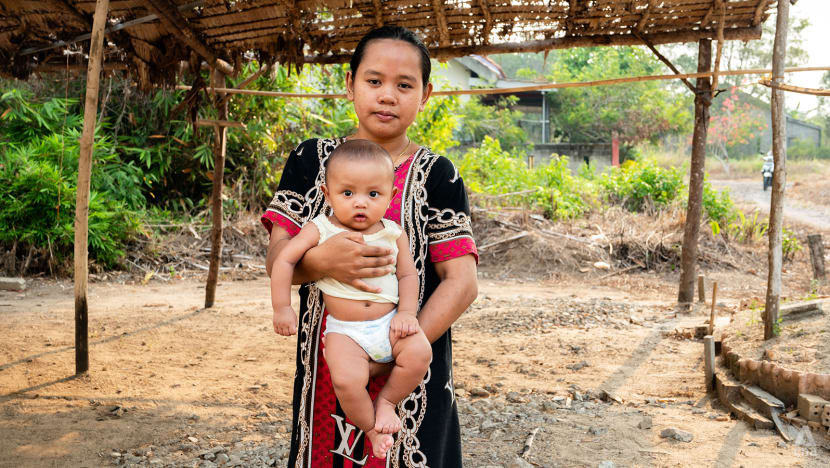
It was the first time in her life she saw a fire so close to her house.
This year marks the return of significant land and forest fires in South Sumatra and nine other provinces in Indonesia. Land fire is when a fire occurs on land not deemed as forest, such as on a plantation or uncultivated soil.
Even though some parts of Indonesia have been battling land and forest fires for years, which have often caused transboundary haze to neighbouring countries such as Singapore and Malaysia, there have been no major fires in the last four years.
But this year, there have been 3,788 hotspots in the country from the beginning of the year to Sep 5, according to the Indonesian environment and forestry ministry. This is an increase of four times compared to last year during the same period.
Authorities have yet to release the latest data, but South Sumatra has more hotpots than other provinces in Sumatra this month.
On Sep 6, for example, there were 386 hotspots in South Sumatra compared to eight in Jambi and Riau, which usually also suffer from forest and land fires, according to the country's meteorological, climatological and geophysical agency.
Given the current El Nino weather, which brings warmer-than-average sea surface temperatures near the equator, resulting in dry weather, the hotspots are expected to last for the next few months. El Nino last occurred between 2018 and 2019.
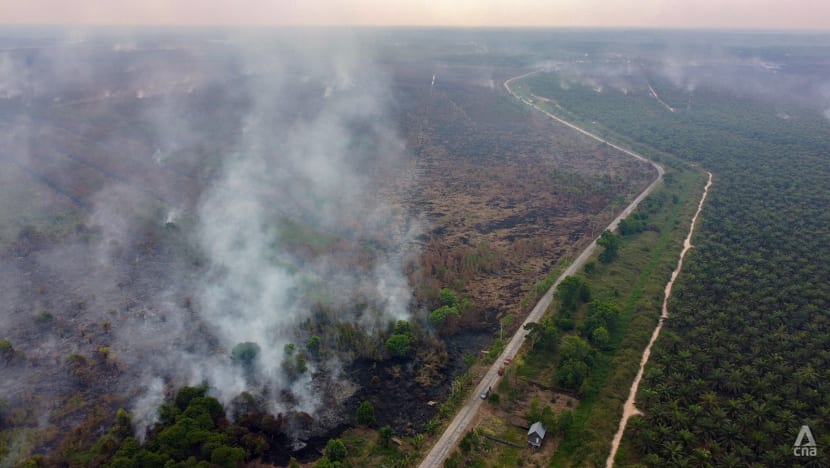
PEATLAND FIRES
Indonesia is no stranger to land and forest fires, which authorities blame on culprits who purposely set fires to clear land, many of them for oil palm plantations since the archipelago is the world’s largest palm oil producer.
The fires are often worsened by dry weather.
“Here in Ogan Komering Ilir, 99 per cent of forest and land fires are caused by humans,” said Mr Muhamad, chief firefighter of Ogan Komering Ilir, who goes by one name.
“(Dry) weather is just a supporting factor."
Speaking to CNA while overseeing his team that was trying to extinguish a peatland fire, Mr Muhamad said there are several methods commonly used by culprits to set fire.
The culprit may start the fire by throwing a lit cigarette into a land or forest or by setting up a mosquito repellent, whose flame is then blown by the wind, resulting in fires.
Mr Muhamad said the fires in Ogan Komering Ilir that started in August may last until November, given the dry weather due to the lack of rain in weeks.
Since the land in the regency is mainly peatland, it is especially hard to extinguish, he pointed out.

Peatlands have layers of partially decayed vegetation and organic matter deep beneath the surface, which can keep smouldering for months if not extinguished properly.
They also store more carbon dioxide than all other vegetation types in the world combined.
Hence, they release huge amounts of carbon dioxide when they get burned.
They can emit smoke despite no visible fire, he said.
“The other challenge is access to the hotspots as many fires are in remote places.
“Second is the lack of access to water because fires usually happen in dry areas,” Mr Muhamad highlighted.
In Indonesia, six of the 38 provinces are historically especially prone to forest and land fires because they are home to peatlands, said Mr Suharyanto, head of the national disaster agency, at the end of July.
They are South Sumatra, Riau and Jambi on Sumatra island and West Kalimantan, Central Kalimantan and South Kalimantan on Indonesia’s Borneo, said Mr Suharyanto when chairing a meeting on forest and land fires in South Kalimantan.
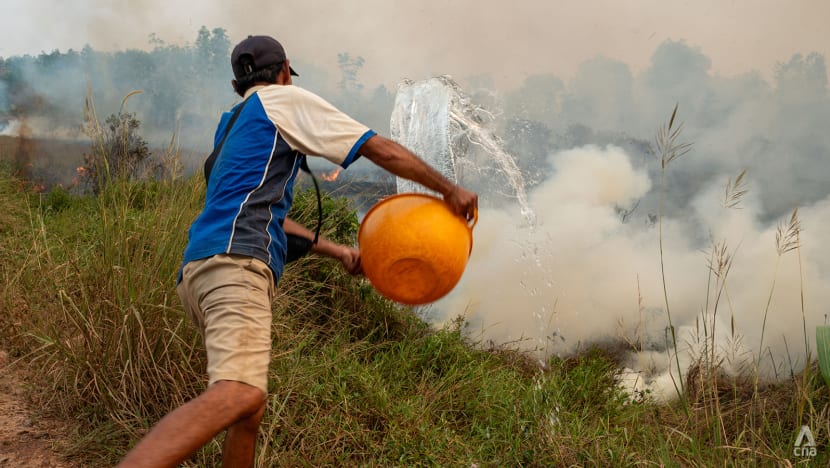
FARMERS NOT WELL-EQUIPPED
Over in Soak Batok village, in neighbouring Ogan Ilir regency, 55-year-old farmer Romli was busy extinguishing a land fire on a hot September afternoon using a backpack pesticide sprayer, which was filled with water instead of pesticide.
His 52-year-old wife Samsiah, also a farmer, tried to help extinguish the fire by pulling a hose that the other villagers were trying to use to put out other fires.
The fire was just across the couple’s land, where they had planted oil palm trees. It was also just a few metres away from their house.
“I’m worried the fire may creep into our house and land.
“I was shaking when I saw the fire. My husband immediately started spraying water, so I helped him,” said Mdm Samsiah, who goes by one name.
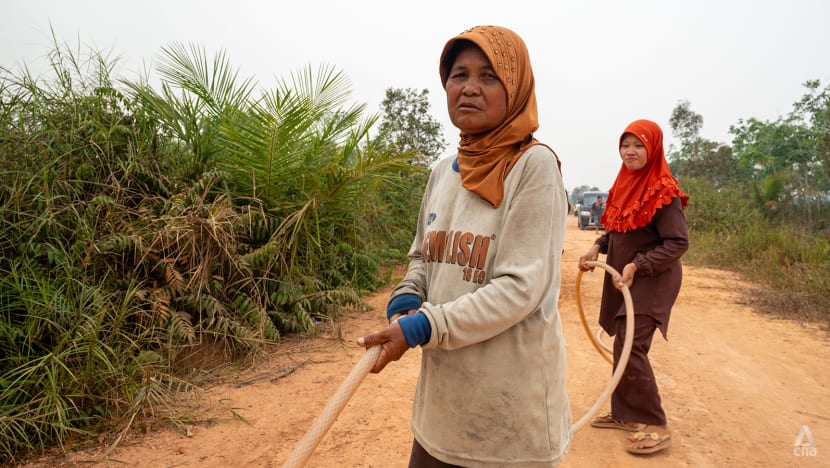
The villagers had sought help by contacting the local firefighters, but given the remoteness of their village, they had yet to arrive when CNA witnessed the fire on Sep 25.
Fortunately, Mr Romli and Mdm Samsiah have a son who works for a company near their village.

The company immediately sent a car with a water tank used by the villagers to extinguish the fire.
It was the second land fire in their village this year; the first happened earlier in the month.
The villagers are not well-equipped to extinguish fires.
“We also use a bucket to extinguish fires,” said Mr Romli, who only has one name.
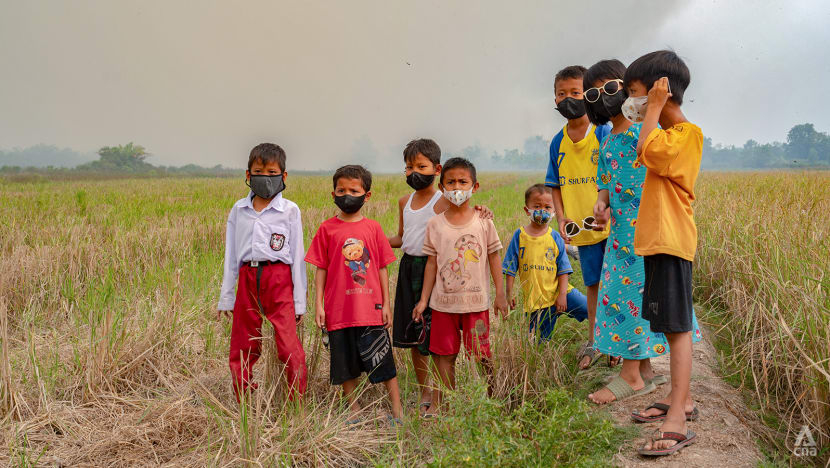
CATCHING PERPETRATORS
Indonesia experienced its biggest fires in decades in 2015 when 2.6 million ha of land were burned.
The daily emissions from the 2015 fires were 15 million tonnes of carbon dioxide per day, according to the World Bank, producing emissions almost twice higher than the daily emissions in the European Union.
It was Indonesia’s greatest carbon emissions since 1997, when it also experienced major forest and land fires. It cost an economic loss of US$16 billion.
Mr Putu Yudha Prawira, deputy director of South Sumatra’s police special criminal investigation directorate, said that the condition in South Sumatra this year is better than in 2015 when the entire province was blanketed by haze due to the fires.
He also said they are better prepared to handle the fires this year.

Thus, he is confident the fires will not cause transboundary haze this year.
“We have set up a (mobile) application to monitor hotspots … we have also deployed teams to hotspot regions, especially peatland areas,” said Mr Prawira.
He asserted that the culprits are usually farmers or people assigned by corporations to set fire for land clearing.
They are currently handling 19 cases and have arrested 34 suspects since August, Mr Prawira added.
The environment and forestry ministry has also sealed off at least six lands owned by corporations in South Sumatra to investigate forest and land fires, the ministry said on Sep 26.
Indonesia is the world’s third largest rainforest area, but it is also one of the world’s top greenhouse gas emitters due to forest fires, peatland degradation and deforestation.
Southeast Asia’s biggest economy has set a target of reaching carbon neutrality by 2060.
Mr Arie Rompas, forest campaign team leader with Greenpeace Indonesia, said the release of carbon dioxide triggers climate change.
Therefore, Indonesia seriously needs to tackle land and forest fires.
“Taking legal action is crucial, especially as a deterrent effect.
“Because based on Greenpeace’s data, incidents continue to happen in the same locations,” he told CNA.
Back in Tanjung Serang village, Mdm Sadriah hopes she will never experience land or forest fires again.
“Hopefully, there will be no fires in the upcoming years, and people will be more careful.
“Because fires cannot start on their own. It must have been the result of humans.”
Read this story in Bahasa Indonesia.


















